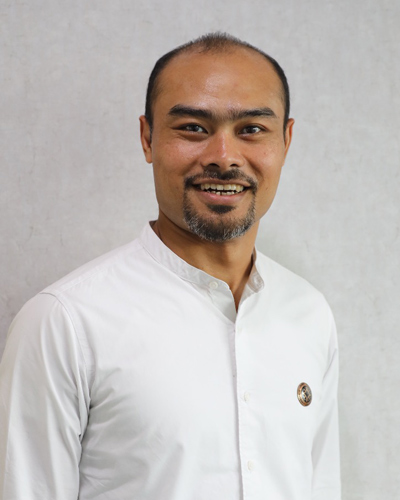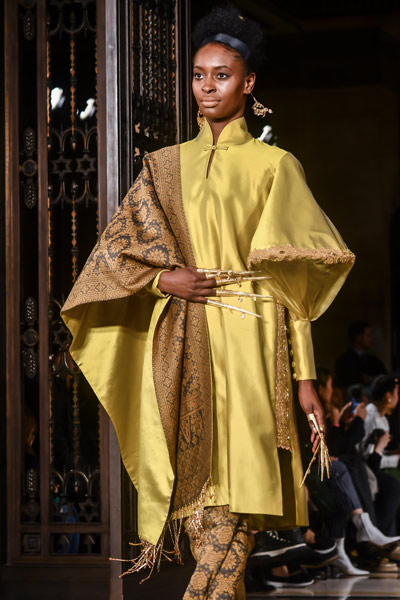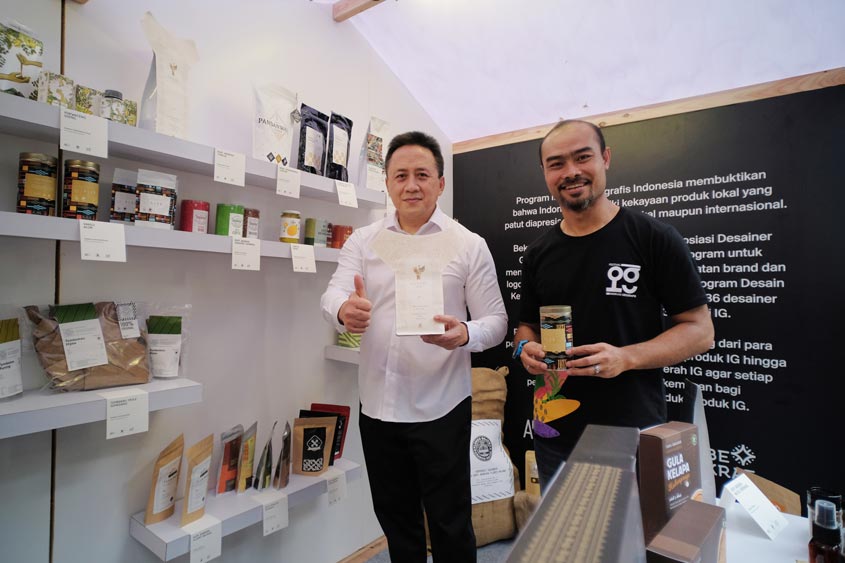
Leveraging Indonesia’s creative economy
By Catherine Jewell, Publications Division, WIPO
Indonesia is South East Asia’s largest economy and one of the world’s most diverse countries – both in terms of its biodiversity and cultural diversity. In 2015, Indonesia’s President Joko Widodo, set up the Indonesian Agency for the Creative Economy (BEKRAF), a non-ministerial agency with a mandate to develop and coordinate policies to harness the huge potential of Indonesia’s creative economy. Ari Juliano Gema, Deputy Chairman for IPR Facilitation and Regulation at BEKRAF, explains what his organization is doing to help Indonesia’s creative businesses thrive.
How big is Indonesia’s creative sector? What are its core strengths?

says Ari Juliano Gema, Deputy Chairman for IPR Facilitation
and Regulation at the Indonesian Agency for the Creative
Economy (BEKRAF) (photo: Courtesy of BEKRAF).
Indonesia’s creative economy is very diverse and covers 16 different sub-sectors (see box). Its performance in recent years demonstrates its strong growth potential. In 2017, the sector generated more than 7 percent of GDP – and employed around 15.9 million people. By 2020, we predict it will be worth around IDR 1.924 trillion (approx. USD 130 million).
Indonesia’s creative economy has huge untapped potential but faces a number of challenges. Much of the sector consists of small and medium-sized enterprises that still only market their products locally. Few of them have any knowledge of how intellectual property (IP) rights can add value to their businesses nor do they have access to the financial capital and technologies required to expand their operations.
The diversity of our culture is a core strength, as is the demographic bonus we enjoy. By 2030, we will have 180 million young people ready to join the workforce. Right now, there is a lot of enthusiasm among young people about the creative economy. Many are setting up startups and developing great creative content and creative events. We also have many successful performers, singers and Youtubers.
Tourism also plays a key role in supporting the sector’s development. You could say that tourism is the skin and the creative industries are the muscle and the flesh. When tourists come to Indonesia, they see all the products we make and often want to take them back home. In a move to support tourism, the Government has identified 10 major tourist destinations in Indonesia. BEKRAF is helping these destinations leverage their culture and the potential of the local creative industries to ensure they remain attractive to tourists.
Indonesia's creative economy
Indonesia’s creative economy comprises 16 sub-sectors, including:
- apps and game development;
- architecture;
- interior design;
- fashion;
- product design;
- visual communication design;
- movies, animation, and video;
- photography;
- crafts;
- culinary arts;
- music;
- publishing;
- advertising;
- performing arts;
- fine art;
- television and radio.
These sub-sectors are expected to make significant contributions to Indonesia’s GDP and to boost exports and employment.
What is BEKRAF’s role?
BEKRAF’s main role is to establish an ecosystem that enables Indonesia’s creative businesses to boost their productivity and thrive. The Agency covers six functions: research, development and education; access to capital; infrastructure, marketing, facilitation; regulation of intellectual property (IP) rights; inter-governmental relations; and interregional relations. We coordinate with other government agencies that have established creative economy support programs in place to ensure that our actions are aligned and coherent. Our overriding aim, of course, is to create the conditions for the creative economy to become a mainstay of national economic performance.
Which sectors stand out in Indonesia’s creative economy?
The fashion, culinary and craft sub-sectors are the most mature and make the biggest contribution to GDP. In fashion, for example, we have a long and rich tradition of batik making and many talented contemporary designers. Our aim is for this sub-sector to sustain its high levels of performance.
Our cultural diversity is our strength. It gives us the means to develop a robust creative economy built on effective use of IP rights.
There are also exciting developments in the areas of film, music and computer apps and gaming, which are recording strong growth. The development of Indonesia’s film industry is particularly exciting. For example, in 2018, 10 Indonesian movies attracted more than 1 million viewers in theatres in Indonesia. Warkop (DKI), a film produced by Falcon Pictures, attracted around 7 million viewers across Indonesia. This was a first. Indonesian movies are also doing well internationally. Marlina the Murderer in Four Acts recently premiered in the United States and Sekala Niskala (Seen and Unseen) became the first Indonesian film to win the Grand Prix at the 2018 Berlin International Film Festival. It went on to win the Asia Pacific Screen Award and the International Feature Fiction Award at the Adelaide Film Festival.
In practical terms, how are you supporting these sub-sectors?

economically important creative sub-sectors
(photo: Picture Capital / Alamy Stock Photo).
We are working to ensure that an effective regulatory framework is in place to support Indonesia’s creative businesses. We are also helping them to access the investment they need to develop and grow. We run a range of initiatives within each sub-sector. For example, in the film sector, we have created opportunities for young filmmakers to spend time at the TorinoFilmLab in Italy to hone their skills. We send some to international film festivals and others to events like the Akatara Indonesian Creative Financing Forum, where they can pitch their ideas to investors. So far this year, the Forum has financed five films that were released in cinemas, with a number of others in production. There’s a lot of interest among foreign investors in co-producing or co-directing films in Indonesia. With around 250 million people, the Indonesian market is very attractive.
Similarly, in the music sector, we organize Indonesia Creative Incorporated (ICINC), an umbrella program to discover, promote and market Indonesia’s creative talent at home and in international markets. We also organize Musikologi, an event that brings together professionals from across the music industry and enables them to share their knowledge and experience with upcoming musicians. The clinics we organize help young musicians to learn about the music business and IP rights. BEKRAF is also working to promote Indonesia’s collective management organization, which is responsible for setting royalty rates and for collecting and re-distributing revenues to artists.
And the BEKRAF Developer Day, which includes a series of master classes and clinics, is an opportunity for software experts to share their knowledge with young enthusiasts keen to learn new skills. Access to such training opportunities is very limited in Indonesia, so these events are very popular. Various government-funded initiatives also allow us to send promising startups to international events like the SXSW Conference and the Startup World Cup in the United States. Such participation shows the world that Indonesia has some very talented software developers.
In fashion, one of the largest and most mature sectors in Indonesia, we play a supporting role, for example, by researching fashion trends and offering government grants to upcoming designers. Similarly, in the craft sector, we support events like Inacraft. We also help artisans take part in international gatherings like NY Now, the world’s biggest craft event. Our workshops for batik makers help these artisans improve their professional standing and the quality of their outputs so they become more competitive.
In Indonesia, we can’t compete on technology, but we can compete with our creativity and culture.
What role does IP play in adding value to Indonesia’s cultural assets?
IP is at the heart of the creative economy. Without IP protection, a product becomes a simple commodity; there is no value added. That is why raising awareness across the creative sector about the advantages that can flow from the strategic use of IP assets is a top priority.

What the producers of the famous Indonesian movie, Ada Apa Dengan Chinta (What’s Up with Love), were able to accomplish is a recent example of what can be achieved through strategic use of IP rights. Released in 2004, the movie was a box office hit. Recognizing an opportunity to leverage its popularity, the producers signed licensing deals for a TV series and merchandizing (e.g. T-shirts and other fashion items). In so doing, they were able to generate enough money to finance a sequel and other box office hits, including Filosofi Kopi (Coffee Philosophy), from which they created an eponymous coffee shop. BEKRAF’s role is to facilitate the flow of capital to Indonesia’s creative businesses and to support the monetization and commercialization of the country’s many creative assets by encouraging creative businesses to think more strategically about their IP assets.
So how are you building awareness?
Building IP awareness in Indonesia is very challenging. Only around 11 percent of actors in Indonesia’s creative economy have acquired IP rights. To address this, we organize IP awareness activities regularly in cities around the country. These events are an opportunity for creative businesses to learn about IP and connect with potential investors. The growing number of media outlets covering IP-related issues is an indication of the solid progress we are making.
BEKRAF also recently launched its mobile app, BIIMA (Bekraf IPR Info on Mobile Apps) which gives users basic information about IP rights. You simply open the application and select a product (there are many options) to find out about the IP rights relevant to it, what you need to do to obtain those rights and how much it costs. Our aim is to hit 1 million users by 2022. We launched it in July 2016 – it took us about six months to develop – and so far, we have around 1,500 subscribers. BIIMA is a practical tool to raise understanding of IP among small businesses and artisan communities so they can better protect their IP interests and leverage the value of their IP assets.
Is counterfeiting and piracy a big issue?
Yes, as is the case in many countries, we face challenges in this area. BEKRAF has established an anti-piracy taskforce, and while we don’t have the authority to investigate IP infringement cases, we give creative businesses practical guidance and advice when their products are infringed. In summary, we connect creative economy actors with enforcement authorities. This is important because if creators don’t report cases of IP infringement, enforcement authorities can’t do anything.
Online piracy is also a big issue right now because many people still don’t have access to legitimate streaming platforms. But piracy arises not just because it is difficult to access legitimate products or because the price is too high, addictive behavior is another major factor. Although they know it is wrong, some online users still buy pirated copies of creative works. How do we tackle this? Imposing strong sanctions has not been very effective. Education is the key to changing such behavior. We need to teach people from the earliest age about the damage that piracy and counterfeiting causes and such education needs to be comprehensive and continuous.
How do you see Indonesia’s creative economy evolving?
The creative economy will become the backbone of the Indonesian economy. It already generates around IDR 1.100 trillion annually. Our cultural diversity is our strength. It gives us the means to develop a robust creative economy built on effective use of IP rights. That will enable Indonesia to realize its economic ambitions and to promote social progress and cultural development. All Indonesians stand to benefit from the wealth generated by the continued development and expansion of our creative economy.
What message do you have for Indonesia’s creative businesses?
By 2030, Indonesia is projected to become one of the world’s largest economies. To take advantage of this economic expansion, creative businesses need to recognize that the only way they can reap the full economic benefit of their innovations and their creative work is to protect it with IP rights. They need to become more IP savvy. They need to develop strategies and systems that will enable them to harness the value of their work in a rapidly evolving business landscape. So my message is, keep innovating, be sure to protect your work with IP and enjoy the ride!
What are BEKRAF’s future objectives?
Our ongoing objectives are to ensure the creative economy becomes a new pillar of the Indonesian economy and that Indonesia becomes an established global creative economic player by 2030. To this end, in 2018, BEKRAF organized the first World Conference on Creative Economy in Bali around the theme of “Inclusive Creativity,” to promote the creative economy as a vehicle for equal opportunities and inclusion. In line with this vision, BEKRAF will continue to focus its efforts on promoting understanding among the creative business community and beyond, of the advantages of astute protection and management of their IP assets. This is essential in creating the conditions for these businesses to thrive in international markets.
The WIPO Magazine is intended to help broaden public understanding of intellectual property and of WIPO’s work, and is not an official document of WIPO. The designations employed and the presentation of material throughout this publication do not imply the expression of any opinion whatsoever on the part of WIPO concerning the legal status of any country, territory or area or of its authorities, or concerning the delimitation of its frontiers or boundaries. This publication is not intended to reflect the views of the Member States or the WIPO Secretariat. The mention of specific companies or products of manufacturers does not imply that they are endorsed or recommended by WIPO in preference to others of a similar nature that are not mentioned.